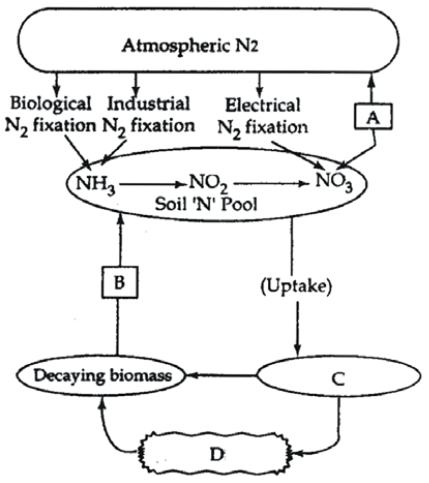Study the cycle shown below and select the option which gives correct words for all the four blanks A, B, C and D.
|
A |
B |
C |
D |
|
Nitrification |
Ammonification |
Animals |
plants |
|
A |
B |
C |
D |
|
Dentirificiation |
Ammonification |
Plants |
Animals |
|
A |
B |
C |
D |
|
Nitrification |
Denitrification |
Animals |
Plants |
|
A |
B |
C |
D |
|
Nitrification |
Denitrification |
Animals |
Plants |
B.
|
A |
B |
C |
D |
|
Dentirificiation |
Ammonification |
Plants |
Animals |
A- Denitrification
B-Ammonification
C- Plants
D-Animals
Which one of the following is being tried in India as a biofuel substitute for fossil fuels
Jatropha
Azadirachta
Musa
Musa
A.
Jatropha
Biofuels are substances of biological origin which are used for the production of heat and another form of energy. Often biologically generated hydrogen, methane, ethanol, butanol and diesel are referred to as biohydrogen, biomethane, bioethanol, biobutanol and biodiesel respectively. Petro plans are the plants which can yield a large amount of latex having long chained liquid hydrocarbon, eg, Jatropha, Euphorbia (family-Euphorbiaceae) and other members of Euphorbiaceae, Asclepiadaceae, Apocyanaceae.
The wood used as a source of energy is called fuel wood. The good fuelwood should be free from resin, much smoke and offensive odours. Hardwood is generally good fuel wood, Casuarina, Azadirachta, Dalbergia, Terminalia.
Which one of the following types of organisms occupy more than one trophic level in a pond ecosystem?
Phytoplankton
Fish
Zoonplankton
Zoonplankton
B.
Fish
In a pond ecosystem fishes occupy the more than one trophic levels.
DDT residues are rapidly passed through food chain causing biomagnification because DDT is
liposoluble
moderately toxic
non-toxic to aquatic animals
non-toxic to aquatic animals
A.
liposoluble
Many pesticides, such as DDT, aldrin and dieldrin are accumulated in the environment. They are fat soluble and generally non-biodegradable, They get incorporated into the food chain and ultimately deposited in the fatty tissue of animals and humans. In the food chain because of their build up, they get magnified in the higher trophic levels called biological magnification. The phenomenon of biological magnification is also reported of certain other pollutants such as heavy metals.eg, mercury, copper and radioactive substances as strontium-90
The Indian rhinoceros is a natural inhabitant of which one of the Indian states?
Uttarakhand
Uttar Pradesh
Himachal Pradesh
Himachal Pradesh
D.
Himachal Pradesh
Indian rhinoceros (Rhinoceros unicornis) is a natural inhabitant of Assam is India. It is now protected in Kaziranga National Park situated at sib sager in Jorhat district of Assam.
